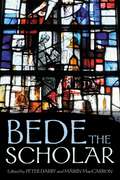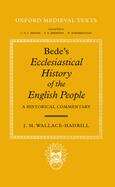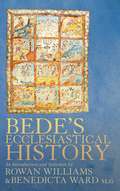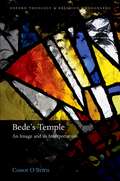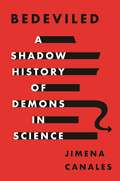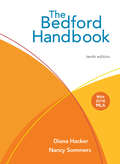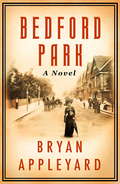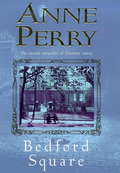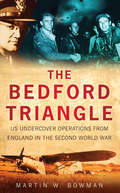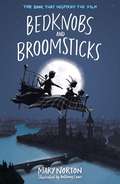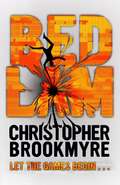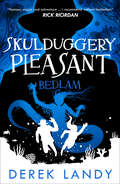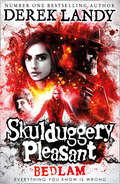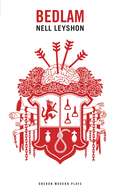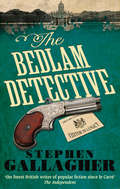- Table View
- List View
Bede and the Future (Studies in Early Medieval Britain and Ireland)
by Faith Wallis Peter DarbyBede (c. 673-735) was Anglo-Saxon England’s most prominent scholar, and his body of work is among the most important intellectual achievements of the entire Middle Ages. Bede and the Future brings together an international group of Bede scholars to examine a number of questions about Bede’s attitude towards, and ideas about, the time to come. This encompasses the short-term future (Bede’s own lifetime and the time soon after his death) and the end of time. Whilst recognising that these temporal perspectives may not be completely distinct, the volume shows how Bede’s understanding of their relationship undoubtedly changed over the course of his life. Each chapter examines a distinct aspect of the subject, whilst at the same time complementing the other essays, resulting in a comprehensive and coherent volume. In so doing the volume asks (and answers) new questions about Bede and his ideas about the future, and will undoubtedly stimulate further research in this field.
Bede and Time: Computus, Theology and History in the Early Medieval World (Studies in Early Medieval Britain and Ireland)
by Máirín MacCarronThe Venerable Bede (c. 673–735) was the leading intellectual figure of the early Anglo-Saxon Church, and his extensive corpus of writings encompassed themes of exegesis, computus (dating of Easter and construction of calendars), history and hagiography. Rather than look at these works in isolation, Máirín MacCarron argues that Bede’s work in different genres needs to be read together to be properly understood. This book provides the first integrated analysis of Bede’s thought on time, and demonstrates that such a comprehensive examination allows a greater understanding of Bede’s writings on time, and illuminates the place of time and chronology in his other works. Bede was an outstanding intellect whose creativity and ingenuity were apparent in various genres of writing. This book argues that in innovatively combining computus, theology and history, Bede transformed his contemporaries’ understanding of time and chronology.
Bede and Time: Computus, Theology and History in the Early Medieval World (Studies in Early Medieval Britain and Ireland)
by Máirín MacCarronThe Venerable Bede (c. 673–735) was the leading intellectual figure of the early Anglo-Saxon Church, and his extensive corpus of writings encompassed themes of exegesis, computus (dating of Easter and construction of calendars), history and hagiography. Rather than look at these works in isolation, Máirín MacCarron argues that Bede’s work in different genres needs to be read together to be properly understood. This book provides the first integrated analysis of Bede’s thought on time, and demonstrates that such a comprehensive examination allows a greater understanding of Bede’s writings on time, and illuminates the place of time and chronology in his other works. Bede was an outstanding intellect whose creativity and ingenuity were apparent in various genres of writing. This book argues that in innovatively combining computus, theology and history, Bede transformed his contemporaries’ understanding of time and chronology.
Bede the scholar
by Peter Darby Máirín MacCarronDistilling a decade of research by leading experts on the Venerable Bede, Bede the scholar investigates the Northumbrian monk’s place within the wider intellectual developments of the early medieval world. Demonstrating the centrality of the Bible to his scholarship, chapters focus on Bede’s engagement with scriptural languages, his knowledge and use of earlier works of Latin literature, and a pastoral commitment to teaching and preaching. The book breaks new ground for our understanding of Bede’s self image by investigating his famous Ecclesiastical history of the English people alongside lesser-known works such as the Martyrology, the commentary On Genesis, and the chapter headings he developed for different parts of the Vulgate Bible. Contributors highlight the importance of appreciating Bede’s work within its local setting: the kingdom of Northumbria and the monastery of Wearmouth, whose founders, Benedict Biscop and Ceolfrith, inspired Bede in various ways. The monastery provided an environment in which Bede could flourish, and where he contributed to an intellectual enterprise which also generated the Codex Amiatinus, the earliest one-volume Vulgate to survive fully intact.Combining rigorous scholarly research with a celebration of the depth and complexity of Bede’s work, Bede the scholar deepens our understanding of the scholarly programme undertaken by one of the most important intellectual figures of the early middle ages.
Bede the scholar
by Peter Darby and Máirín MacCarronDistilling a decade of research by leading experts on the Venerable Bede, Bede the scholar investigates the Northumbrian monk’s place within the wider intellectual developments of the early medieval world. Demonstrating the centrality of the Bible to his scholarship, chapters focus on Bede’s engagement with scriptural languages, his knowledge and use of earlier works of Latin literature, and a pastoral commitment to teaching and preaching. The book breaks new ground for our understanding of Bede’s self image by investigating his famous Ecclesiastical history of the English people alongside lesser-known works such as the Martyrology, the commentary On Genesis, and the chapter headings he developed for different parts of the Vulgate Bible. Contributors highlight the importance of appreciating Bede’s work within its local setting: the kingdom of Northumbria and the monastery of Wearmouth, whose founders, Benedict Biscop and Ceolfrith, inspired Bede in various ways. The monastery provided an environment in which Bede could flourish, and where he contributed to an intellectual enterprise which also generated the Codex Amiatinus, the earliest one-volume Vulgate to survive fully intact.Combining rigorous scholarly research with a celebration of the depth and complexity of Bede’s work, Bede the scholar deepens our understanding of the scholarly programme undertaken by one of the most important intellectual figures of the early middle ages.
Bede's Ecclesiastical History Of The English People: A Historical Commentary (Oxford Medieval Texts)
by J. M. Wallace-HadrillBede's Ecclesiastical History of the English People is recognized as a masterpiece among the historical literature of medieval England and Europe. Completed in 731, it comprises in a single flowing narrative a coherent history of the conversion of the English peoples to Christianity, and thestory of the island kingdoms and churches from the 590s to the early eighth century, prefaced by a sketch of the earlier history of Britain. In 1969 the Clarendon Press published the new edition in Oxford Medieval Texts, edited by Bertram Colgrave and Sir Roger Mynors. Mynors's masterly text and textual introduction replaced much of Charles Plummer's great edition of 1896; but the historical notes did not attempt to match in scale anddetail Plummer's second volume of commentary. To fill this gap the late Professor J. M. Wallace-Hadrill devoted the last years of his life to a new commentary, one of the finest and most mature fruits of his scholarship - more succinct than Plummer, tauter, more relevant, above all drawing togetherand adding to the findings of a galaxy of modern scholars. Prepared for the press by Thomas Charles-Edwards, helped by Patrick Wormald and others, this book completes the new Bede, and is prefaced by a paper characteristic of Professor Wallace-Hadrill on 'Bede and Plummer'.
Bede's Ecclesiastical History of the English People: An Introduction and Selection
by Benedicta Ward Rowan WilliamsBede's best known work, An Ecclesiastical History of the English People, was written in Latin and is not immediately easy to understand and follow. Yet it is a key text for any student of English history. Rowan Williams shows in his introduction how Bede works to create a sense of national destiny for the new English kingdoms of the seventh century, a sense that has helped to shape English self-awareness through the centuries, by using the imagery both of imperial Rome and of biblical Israel. But Bede also wrestles with the difficult question of how the Church relates to and serves the political order. The attraction and fascination of his work is partly in seeing the tension between the strategic use of wealth and political power for religious ends and the example of self-effacing service and simplicity of life offered by some of Bede's greatest Christian heroes. The issues around these questions are not academic or antiquarian. Understanding Bede is a key to understanding British society in the present as well as the past.
Bede's Ecclesiastical History of the English People: An Introduction and Selection
by Rowan Williams Benedicta WardBede's best known work, An Ecclesiastical History of the English People, was written in Latin and is not immediately easy to understand and follow. Yet it is a key text for any student of English history. Rowan Williams shows in his introduction how Bede works to create a sense of national destiny for the new English kingdoms of the seventh century, a sense that has helped to shape English self-awareness through the centuries, by using the imagery both of imperial Rome and of biblical Israel. But Bede also wrestles with the difficult question of how the Church relates to and serves the political order. The attraction and fascination of his work is partly in seeing the tension between the strategic use of wealth and political power for religious ends and the example of self-effacing service and simplicity of life offered by some of Bede's greatest Christian heroes. The issues around these questions are not academic or antiquarian. Understanding Bede is a key to understanding British society in the present as well as the past.
Bede's Temple: An Image and its Interpretation (Oxford Theology and Religion Monographs)
by Conor O'BrienThis volume examines the use of the image of the Jewish temple in the writings of the Anglo-Saxon theologian and historian, Bede (d. 735). The various Jewish holy sites described in the Bible possessed multiple different meanings for Bede and therefore this imagery provides an excellent window into his thought. Bede's Temple: An Image and its Interpretation examines Bede's use of the temple to reveal his ideas of history, the universe, Christ, the Church, and the individual Christian. Across his wide body of writings Bede presented an image of unity, whether that be the unity of Jew and gentile in the universal Church, or the unity of human and divine in the incarnate Christ, and the temple-image provided a means of understanding and celebrating that unity. Conor O'Brien argues that Bede's understanding of the temple was part of the shared spirituality and communal discourse of his monastery at Wearmouth-Jarrow, in particular as revealed in the great illuminated Bible made there: the Codex Amiatinus. Studying the temple in Bede's works reveals not just an individual genius, but a monastic community engaged actively in scriptural interpretation and religious reflection. O'Brien makes an important contribution to our understanding of early Anglo-Saxon England's most important author, the world in which he lived, and the processes that inspired his work.
Bedeviled: A Shadow History of Demons in Science
by Jimena CanalesHow scientists through the ages have conducted thought experiments using imaginary entities—demons—to test the laws of nature and push the frontiers of what is possible Science may be known for banishing the demons of superstition from the modern world. Yet just as the demon-haunted world was being exorcized by the enlightening power of reason, a new kind of demon mischievously materialized in the scientific imagination itself. Scientists began to employ hypothetical beings to perform certain roles in thought experiments—experiments that can only be done in the imagination—and these impish assistants helped scientists achieve major breakthroughs that pushed forward the frontiers of science and technology.Spanning four centuries of discovery—from René Descartes, whose demon could hijack sensorial reality, to James Clerk Maxwell, whose molecular-sized demon deftly broke the second law of thermodynamics, to Darwin, Einstein, Feynman, and beyond—Jimena Canales tells a shadow history of science and the demons that bedevil it. She reveals how the greatest scientific thinkers used demons to explore problems, test the limits of what is possible, and better understand nature. Their imaginary familiars helped unlock the secrets of entropy, heredity, relativity, quantum mechanics, and other scientific wonders—and continue to inspire breakthroughs in the realms of computer science, artificial intelligence, and economics today.The world may no longer be haunted as it once was, but the demons of the scientific imagination are alive and well, continuing to play a vital role in scientists' efforts to explore the unknown and make the impossible real.
Bedeviled: A Shadow History of Demons in Science
by Jimena CanalesHow scientists through the ages have conducted thought experiments using imaginary entities—demons—to test the laws of nature and push the frontiers of what is possible Science may be known for banishing the demons of superstition from the modern world. Yet just as the demon-haunted world was being exorcized by the enlightening power of reason, a new kind of demon mischievously materialized in the scientific imagination itself. Scientists began to employ hypothetical beings to perform certain roles in thought experiments—experiments that can only be done in the imagination—and these impish assistants helped scientists achieve major breakthroughs that pushed forward the frontiers of science and technology.Spanning four centuries of discovery—from René Descartes, whose demon could hijack sensorial reality, to James Clerk Maxwell, whose molecular-sized demon deftly broke the second law of thermodynamics, to Darwin, Einstein, Feynman, and beyond—Jimena Canales tells a shadow history of science and the demons that bedevil it. She reveals how the greatest scientific thinkers used demons to explore problems, test the limits of what is possible, and better understand nature. Their imaginary familiars helped unlock the secrets of entropy, heredity, relativity, quantum mechanics, and other scientific wonders—and continue to inspire breakthroughs in the realms of computer science, artificial intelligence, and economics today.The world may no longer be haunted as it once was, but the demons of the scientific imagination are alive and well, continuing to play a vital role in scientists' efforts to explore the unknown and make the impossible real.
The Bedford Handbook (10th Ed)
by Diana Hacker Nancy SommersA coherent reference that covers all the topics student writers come across in a writing course, supporting composition for different purposes and audiences and in a variety of genres and as they collaborate, revise deeply, conduct research, document sources, format their writing, and edit for clarity. Recognising that the best student writers succeed because they practice writing, reading, thinking, and researching on a regular basis, the handbook fosters a culture of practice with how-to instruction for writing tasks, with advice that allows students to pivot among disciplines, and with more print and digital activities than any other college writing resource.
Bedford Park
by Bryan AppleyardAn evocative historical thriller based in one of London's original suburbs.Set in 1912, Bedford Park is not just a London suburb: it is a crucible for enlightenment and modernity inhabited by people who wish to better themselves - and those who should know better. It is a singular place, architecturally sidestepping the modern whilst encouraging those with new ideas to take up residence.Into this mix sails Cal Kidd from America. In a coffee-house he makes the acquaintance of Binks, a man whose occupation in the City is vague but he seems to know everybody. And so Cal meets real-life characters like Maud Gonne and Frank Harris, while Ford Madox Ford, W.B. Yeats and Joseph Conrad appear also. Then Binks is gruesomely murdered, and after never really having to deal with anything in his life, Cal the observer now has to act.The spirit of the age is what makes BEDFORD PARK so evocative, a time when everyone tries to invoke the future but often looks to the past to achieve it. Among the host of vivid characters, the greatest is London itself, a city in a constant state of flux whose centre is journalism. All the detail makes the place exotic and exciting - the marathon at the Olympics in 1908, a ride on the Flip Flap in White City, news being chalked up on dock walls for those who couldn't afford papers, a woman peeling potatoes in the Biosphere cinema in Bishopsgate. London has to comment instantly upon itself or be commented upon, always new and important.
Bedford Square: Murder, intrigue and class struggles in Victorian London (Thomas Pitt Mystery #19)
by Anne PerryA suspicious death leads Pitt to the doorstep of one of London's most respectable households... Bedford Square is the nineteenth novel in bestselling author Anne Perry's highly acclaimed mystery series featuring Thomas Pitt, and sees the detective investigating a murder steeped in class prejudice. Perfect for fans of C. J. Sansom and Sherlock Holmes.'Ms Perry fashions a Victorian story with the sophisticated characterisation and psychological suspense that are everyday tools of the contemporary writer... the result is first rate' - New York Times Book Review When a man is found murdered on the doorstep of a respectable house in Bedford Square, Victorian England's finest and most controversial policeman, Thomas Pitt, is called immediately to the scene. The only clue to the victim's identity is a silver snuff box found on the body, curiously at odds with the man's dishevelled appearance. Pitt soon discovers that the box, and the house where the body was found, belong to General Balantyne, a man Pitt knows to be a pillar of the community. He is dismayed to learn that Balantyne can barely recall the evening, let alone account for his movements... What readers are saying about Bedford Square: 'I thoroughly enjoyed Perry's ability to show me around the streets of Victorian London, a very realistic journey that added a lot of spice to the adventure''[Anne Perry's] books are always gripping and beautifully written''Five stars'
The Bedford Triangle: US Undercover Operations from England in the Second World War
by Martin W. BowmanThe Bedford Triangle portrays the crucial part played by the British Special Operations Executive (SOE),US Army Air Force (USAAF) and American Office of Strategic Services (OSS) in operations behind enemy lines in occupied Europe during World War Two. Milton Ernest Hall, a country house in Bedfordshire used officially as the UK headquarters of the US Army Airforce Service Command, was located at the heart of a network of top secret Allied Radio and propaganda transmitting stations, political warfare units and undercover British and American formations dealing in espionage and subterfuge. Martin Bowman draws upon revealing first-hand accounts, together with official documentary evidence, to provide tantalising glimpses of the cloak and dagger operations. The author's extensive research has revealed that Allied Secret Service organisations participated in even more unorthodox activities, such as clandestine propaganda and political warfare. He also reveals the truth behind what really happened to legendary band leader Glenn Miller.
Bedfordshire Folk Tales (Folk Tales Ser.)
by Jen FoleyOnce covered in forest, marsh and fen, yet lush with farmland, Bedfordshire has been hit by wave after wave of invaders, each bringing their own tales which have become rooted in the oral tradition of storytelling. Scratch under the surface and you will find settlements of ancient Britons razed to the ground and ruined castles. The landscape rings with the stories of robber barons, conniving highwaymen and lonely women condemned as witches, characters brought to life here by noted storyteller Jen Foley. Richly illustrated with thirty unique drawings, these enchanting tales tall and true, ancient and recent, powerful and fantastical will appeal to young and old and can be enjoyed by readers time and again.
Bedknobs and Broomsticks (G.k. Hall Large Print For Young Readers Ser.)
by Mary NortonA brand new paperback edition of BEDKNOBS AND BROOMSTICKS, comprised of the two favourite magical classics THE MAGIC BEDKNOB and BONFIRES AND BROOMSTICKS.When prim and proper Miss Price from next door falls off her broomstick, Carey, Charles and Paul discover that she's actually a witch. In order to keep them quiet, Miss Price gives the three children a gift - an enchanted bedknob that will whisk them off anywhere they want, for as long as they keep her secret. And so their adventures begin...Discover The Magic Bedknob and Bonfires and Broomsticks, two stories full of magic from much-loved author Mary Norton, and the inspiration behind the classic film.
Bedlam
by Christopher BrookmyreHEAVEN IS A PRISON. HELL IS A PLAYGROUND.Ross Baker is an overworked scientist developing medical technology for corporate giant Neurosphere, but he'd rather be playing computer games than dealing with his nightmare boss or slacker co-workers.He volunteers as a test candidate for the new tech - anything to get out of the office for a few hours. But when he emerges from the scanner he discovers he's not only escaped the office, but possibly escaped real life for good. He's trapped in Starfire - a video game he played as a child - with no explanation, no backup and, most terrifyingly, no way out.
Bedlam: London's Hospital for the Mad
by Paul ChambersBETHLEM HOSPITAL is the oldest mental institution in the world, to many famously known as ‘Bedlam’: a chaotic madhouse that brutalised its patients. Paul Chambers explores the 800-year history of Bethlem and reveals fascinating details of its ambivalent relationship with London and its inhabitants, the life and times of the hospital’s more famous patients, and the rise of a powerful reform movement to tackle the institution’s notorious policies. Here the whole story of Bethlem Hospital is laid bare to a new audience, charting its well-intended beginnings to its final disgrace and reform.
Bedlam (Skulduggery Pleasant #12)
by Derek LandyThe 12th explosive novel in the internationally bestselling Skulduggery Pleasant series, BEDLAM will blow your mind – and change everything…
Bedlam (Skulduggery Pleasant #12)
by Derek LandyThe 12th explosive novel in the internationally bestselling Skulduggery Pleasant series, BEDLAM will blow your mind – and change everything…
Bedlam (Oberon Modern Plays)
by Nell LeyshonSet in the notorious 18th Century lunatic asylum that gives the play its name, Bedlam is the story of how a cruel and unusual institution starts to crumble, after the arrival of an unassuming country girl.Nell Leyshon’s new play is an anarchic tale of madness and sanity, authority and incarceration and the arbitrary lines that separate them.Full of violence, romance and reverie, Bedlam made history in September 2010 when it became the first ever production by a female writer to be staged at Shakespeare’s Globe Theatre.
The Bedlam Detective
by Stephen GallagherSir Owain Lancaster is either a madman or a monster... And Sebastian Becker’s role in Bedlam as special investigator for the Master of Lunacy is to determine which is true. Sir Owain’s sanity has been in question ever since a disastrous Amazonian adventure killed his family and colleagues. However, when two local children are found brutally slain, Lancaster claims that the same dark forces that devastated his expedition have followed him home...
Bedlam in the New World: A Mexican Madhouse in the Age of Enlightenment
by Christina RamosA rebellious Indian proclaiming noble ancestry and entitlement, a military lieutenant foreshadowing the coming of revolution, a blasphemous Creole embroiderer in possession of a bundle of sketches brimming with pornography. All shared one thing in common. During the late eighteenth century, they were deemed to be mad and forcefully admitted to the Hospital de San Hipolito in Mexico City, the first hospital of the New World to specialize in the care and custody of the mentally disturbed. Christina Ramos reconstructs the history of this overlooked colonial hospital from its origins in 1567 to its transformation in the eighteenth century, when it began to admit a growing number of patients transferred from the Inquisition and secular criminal courts. Drawing on the poignant voices of patients, doctors, friars, and inquisitors, Ramos treats San Hipolito as both a microcosm and a colonial laboratory of the Hispanic Enlightenment—a site where traditional Catholicism and rationalist models of madness mingled in surprising ways. She shows how the emerging ideals of order, utility, rationalism, and the public good came to reshape the institutional and medical management of madness. While the history of psychiatry's beginnings has often been told as seated in Europe, Ramos proposes an alternative history of madness's medicalization that centers colonial Mexico and places religious figures, including inquisitors, at the pioneering forefront.


